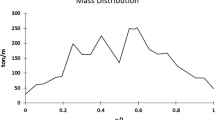Abstract
In this article, the role of the restoring stiffness, as one of the basic parameters in ship hydroelastic analysis, is brought out. It is formulated using the variational principle and the method of virtual displacements. It is shown that asymmetry of the restoring stiffness is a physical reality. Moreover, it is confirmed that modal variation, still disputed in the relevant literature, has to be taken into account to satisfy the ship’s stability. Consistent stiffness is formulated here by regarding stiffness definition as relation between forces and displacements. Hybrid stiffness known from the literature is wrong since some terms are specified as relation between forces and displacement gradient. Influence of the consistent and symmetrized stiffness matrix, and the hybrid one, on dynamic response is illustrated for a prismatic pontoon and a large container ship. It is found that the latter two matrices do not assure convergence of transfer functions of sectional forces to zero value as the wave frequency approaches zero. The rigid body and elastic responses are compared, and pertinent conclusions are drawn. It is also shown that it is not necessary to use the unified geometric and restoring stiffness for ordinary hydroelastic analysis of ship structures. The consistent formulation of the restoring stiffness matrix will be useful for extending linear potential theory hydrodynamic codes for rigid body analysis to deformable bodies.
Similar content being viewed by others
References
Senjanović I, Malenica Š, Tomašević S (2008) Investigation of ship hydroelasticity. Ocean Eng 35: 523–535
Senjanović I, Malenica Š, Tomašević S (2008) Hydroelasticity of large container ships. Mar Struct 22: 287–314
Salvesen N, Tuck EO, Faltinsen O (1970) Ship motion and sea loads. Trans SNAME 70: 250–287
Price WG, Wu Y (1985) Hydroelasticity of marine structures. In: Niordson FI, Olhoff N (eds) Theoretical and applied mechanics. Elsevier, Amsterdam, pp 311–337
Bishop RED, Price WG, Wu YA. (1986) General linear hydroelasticity theory of floating structures moving in a seaway. Philos Trans R Soc Lond A 316: 375–426 (A1538)
Hirdaris SE, Price WG, Temarel P (2003) Two and three-dimensional hydroelastic analysis of a bulker in waves. Mar Struct 16: 627–658
Bishop RED, Price WG (1979) Hydroelasticity of ships. Cambridge University Press, Cambridge
Newman JN (1994) Wave effects on deformable bodies. Appl Ocean Res 16: 47–59
Riggs HR (1996) Hydrostatic stiffness of flexible floating structures. In: Proceedings of international workshop on Very large floating structures, Hayama, Japan, pp 229–234
Huang LL, Riggs HR (2000) The hydrostatic stiffness of flexible floating structure for linear hydroelasticity. Mar Struct 13: 91–106
Riggs HR (2009) Comparison of formulations for the hydrostatic stiffness of flexible structures. J Offshore Mech Arct Eng 131:024501
Senjanović I, Tomić M, Tomašević S (2008) An explicit formulation for restoring stiffness and its performance in ship hydroelasticity. Ocean Eng 35: 1322–1338
Malenica Š (2003) Some aspects of hydrostatic calculations in linear seakeeping. In: Proceedings of the 14th NAV conference, Palermo, Italy, 2003
Molin B (2003) Hidrostatique d’un corps deformable. Technical note, Ecole Superieure d’Ingenieurs de Marseille, Marseille, France
Kreyszig E (1993) Advanced engineering mathematics. Wiley, New York
Bronštajn IN, Semendjejev KA (1991) Mathematical handbook. Tehnička knjiga, Zagreb (in Croatian)
Malenica Š, Molin B, Tuitman JT, Bigot F, Senjanović I (2009) Some aspects of the hydrostatic restoring for elastic bodies. In: The 24th IWWWFB, Saint Petersburg, Russia, pp 141–144
Riggs HR (2008) Discussion of investigation of ship hydroelasticity by Ivo Senjanović, Šime Malenica and Stipe Tomašević. Ocean Eng 35: 1285–1286
Senjanović I. (2008) Reply to Prof. Riggs’ discussion on paper Investigation of ship hydroelasticity by Ivo Senjanović Šime Malenica and Stipe Tomašević. Ocean Eng 35: 1287–1288
Malenica Š, Molin B, Remy F, Senjanović I (2003) Hydroelastic response of a barge to impulsive and non-impulsive wave load. Hydroelasticity in Marine Technology, Oxford, pp 107–115
Noblesse F (1982) The Green function in the theory of radiation and diffraction of regular water waves by a body. J Eng Math 16(2): 137–169
Malenica Š, Tuitman JT (2008) 3D FEM – 3D BEM model for springing and whipping analysis of ships. In: International conference design and operation of container ships, RINA, London
Tomašević S (2007) Hydroelastic model of dynamic response of container ships in waves. PhD thesis, FSB, Zagreb (in Croatian)
Senjanović I, Tomašević S, Vladimir N (2009) An advanced theory of thin-walled girders with application to ship vibrations. Mar Struct 22: 387–437
Senjanović I, Tomašević S, Rudan S, Tomić M, Vladimir N, Malenica Š (2008) Hydroelasticity of very large container ships. In: International conference design and operation of container ships, RINA, London
Senjanović I, Ćatipović I, Tomašević S (2008) Coupled horizontal and torsional vibrations of a flexible barge. Eng Struct 30: 93–109
Lewis EV. (1988) Principles of naval architectures. SNAME, Jersey City
Alfirević I (2003) Introduction to continuum mechanics. University of Zagreb, Golden Marketing, Zagreb (in Croatian)
Mase GT, Mase GE (1999) Continuum mechanics for engineers. CRC, New York
Author information
Authors and Affiliations
Corresponding author
Rights and permissions
About this article
Cite this article
Senjanović, I., Vladimir, N. & Tomić, M. Formulation of consistent restoring stiffness in ship hydroelastic analysis. J Eng Math 72, 141–157 (2012). https://doi.org/10.1007/s10665-011-9468-2
Received:
Accepted:
Published:
Issue Date:
DOI: https://doi.org/10.1007/s10665-011-9468-2




